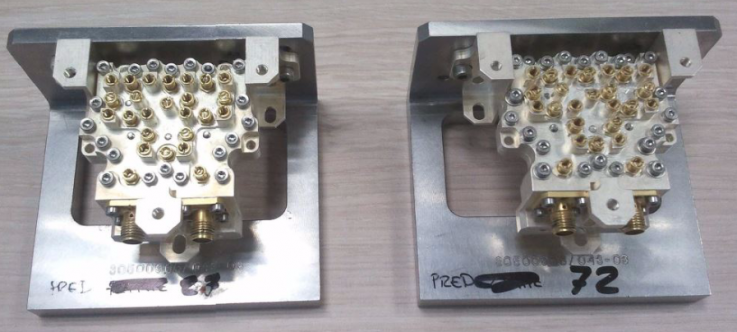-
StatusOngoing
-
Status date2016-11-17
The objective of the activity is to design channel filters for compact Ku-band input multiplexers using pre-distortion and lossy circuit techniques, with the objective of 25% reduction in terms of mass and size. Breadboards for the filters have been designed and characterized. In a second step, channel filters (EMs) have been built and tested for a narrow band and a wide band channel filter to evaluate the developed concepts and demonstrate the technology. Finally, limitations in key performance parameters against the mass and size improvement have been analyzed with respect to conventional un-predistorted Ku-Band IMUX channel filters.

The key issues are:
- Realization of pre-distorted transfer functions
- Implementation of the transfer functions with low-Q & small-dimensions resonators.
Channel filters in input multiplexers (IMUX) take up a substantial portion of modern satellite payloads in terms of size and mass. This is due to the fact that current channel filters are based on volumetric technology for the manufacturing of the resonators. This technology is needed in order to achieve stringent specifications of satellite communication payload in terms of electrical performances, where high filter quality factor (QL) is needed for flatter and more selective response (Figure 1). The classical way to achieve high QL is to use resonator elements with high quality factor (Q0), since filter QL is directly related with that of the resonator elements (Q0). Furthermore, resonator size and Q0 are closely linked, since bigger cavities show higher Q0 than smaller ones.
The novel approach takes advantage of the fact that filters QL, for a given flatness in the transmission response, also depends highly on the synthesis technique used in the filter design. In this sense, significant gains can be made with the proper synthesis choice. This is the main purpose of this activity.
It is worth to mention that given some particular resonator technology with its associated Q0, when used in a filter and due to physical restrictions, it is not possible to indefinitely increase the filter QL. For that reason, a detailed assessment on current (and future) resonator technologies shall be performed at the beginning of the project, in order to identify the most feasible resonator technologies to be applied at filter level.
The activity is split into two phases:
• Phase 1 includes all the activities related with the development of a new feasible filter concept. This includes circuit synthesis and simulation, electromagnetic design and modeling, and BB manufacturing, testing and assessment.
• Phase 2 includes activities devoted to the development and testing of two filter EMs, employing techniques and technology developed in Phase 1.
The project has been successfully completed as of December 2015.
The project has been successfully completed.



